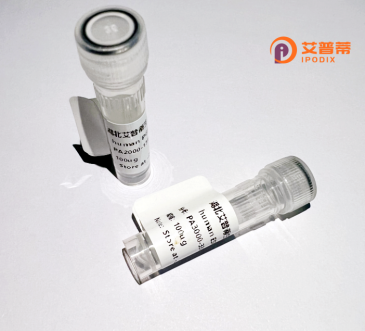
| 纯度 | >90%SDS-PAGE. |
| 种属 | Human |
| 靶点 | Il33 |
| Uniprot No | O95760 |
| 内毒素 | < 0.01EU/μg |
| 表达宿主 | E.coli |
| 表达区间 | 1-270aa |
| 氨基酸序列 | MKPKMKYSTNKISTAKWKNTASKALCFKLGKSQQKAKEVCPMYFMKLRSGLMIKKEACYFRRETTKRPSLKTGRKHKRHLVLAACQQQSTVECFAFGISGVQKYTRALHDSSITGISPITEYLASLSTYNDQSITFALEDESYEIYVEDLKKDEKKDKVLLSYYESQHPSNESGDGVDGKMLMVTLSPTKDFWLHANNKEHSVELHKCEKPLPDQAFFVLHNMHSNCVSFECKTDPGVFIGVKDNHLALIKVDSSENLCTENILFKLSET |
| 分子量 | 57.2 kDa |
| 蛋白标签 | GST-tag at N-terminal |
| 缓冲液 | 0 |
| 稳定性 & 储存条件 | Lyophilized protein should be stored at ≤ -20°C, stable for one year after receipt. Reconstituted protein solution can be stored at 2-8°C for 2-7 days. Aliquots of reconstituted samples are stable at ≤ -20°C for 3 months. |
| 复溶 | Always centrifuge tubes before opening.Do not mix by vortex or pipetting. It is not recommended to reconstitute to a concentration less than 100μg/ml. Dissolve the lyophilized protein in distilled water. Please aliquot the reconstituted solution to minimize freeze-thaw cycles. |
以下为3-4篇关于重组人IL-33蛋白的参考文献及其核心内容概要:
1. **"The IL-33/ST2 axis: Role in health and disease"**
- *Liew, F.Y., et al. (2010)*
- **摘要**:阐释IL-33通过结合ST2受体激活Th2免疫反应,在过敏性哮喘和寄生虫感染中起关键作用,提出重组IL-33在炎症模型中的治疗潜力。
2. **"IL-33 structure and function in immune regulation"**
- *Girard, J.P., et al. (2016)*
- **摘要**:解析重组IL-33的N端染色质结合域与受体结合机制,揭示其通过NF-κB通路调控先天免疫细胞(如肥大细胞)活化的分子基础。
3. **"Recombinant IL-33 activates dendritic cells to promote Th17-mediated lung inflammation"**
- *Besnard, A.G., et al. (2015)*
- **摘要**:通过体内实验证明重组IL-33可驱动树突状细胞分泌IL-23.进而促进Th17分化,加重小鼠肺纤维化,提示其在慢性炎症中的双刃剑效应。
4. **"Therapeutic targeting of IL-33 in eosinophilic airway diseases"**
- *Kearley, J., et al. (2018)*
- **摘要**:动物实验显示重组IL-33诱导的气道高反应性可通过抗IL-33抗体逆转,支持其作为嗜酸性粒细胞相关疾病(如COPD)的干预靶点。
**注**:以上文献均为IL-33研究的里程碑成果,涵盖结构功能、疾病机制及治疗探索方向。如需具体期刊页码,建议通过PubMed或Web of Science检索。
Interleukin-33 (IL-33), a member of the IL-1 cytokine family, functions as both a nuclear chromatin-associated factor and a soluble alarmin released during cellular stress or damage. It plays a critical role in bridging innate and adaptive immunity by activating immune cells, including Th2 lymphocytes, mast cells, and eosinophils, through its receptor ST2 (IL-1RL1). IL-33 is constitutively expressed in epithelial and endothelial tissues, where it contributes to tissue homeostasis. Upon injury, infection, or inflammation, its release triggers pro-inflammatory responses, driving conditions like asthma, allergies, and autoimmune diseases, while also exhibiting protective roles in tissue repair and parasite defense.
Recombinant human IL-33 (rhIL-33) is produced using genetic engineering techniques, often in bacterial (e.g., *E. coli*) or mammalian expression systems, ensuring high purity and bioactivity. This engineered protein retains the functional epitopes needed for receptor binding and signaling, enabling its use in *in vitro* and *in vivo* studies to dissect IL-33-mediated pathways. Researchers leverage rhIL-33 to model diseases, screen therapeutic agents, and explore its dual role as a pro-inflammatory mediator and tissue-protective signal. Its therapeutic targeting—either via inhibition in hyperinflammatory disorders or augmentation in regenerative contexts—represents a growing focus in immunology and drug development.
×